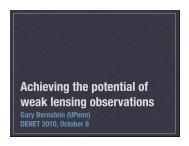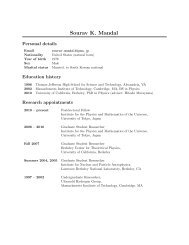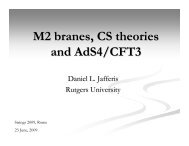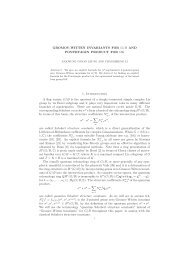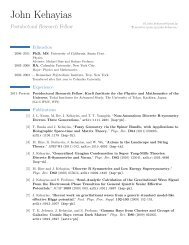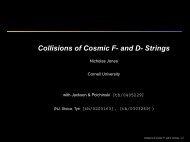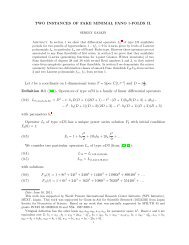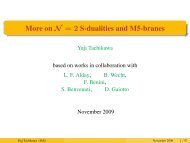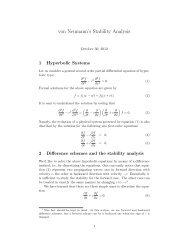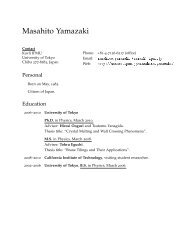STUDY SUMMARY - IPMU
STUDY SUMMARY - IPMU
STUDY SUMMARY - IPMU
Create successful ePaper yourself
Turn your PDF publications into a flip-book with our unique Google optimized e-Paper software.
<strong>SUMMARY</strong> REPORT<br />
WIDE FIELD FIBER-FED OPTICAL<br />
MULTI-OBJECT SPECTROMETER (WFMOS)<br />
The filter and Dewar window used with HSC are replaced by the WFMOS Field Element,<br />
located close to the telescope prime focus. The Field Element is a flat window of 30 mm thickness<br />
and enables efficient coupling of the light from the WFC to the WFMOS fibers. It compensates<br />
for the removal of the Dewar window and filter that are part of the design for HSC. The<br />
Field Element also contains an array of small obscuring spots under which unused spectrograph<br />
fibers can be parked.<br />
An array of 2,400 optical fibers is located in the PFU, with each fiber tip position being controllable<br />
in-plane by a piezo-electric Fiber Positioner, nicknamed “Cobra.” Each fiber tip can be<br />
positioned within its 9.5-mm diameter circular patrol region. The patrol regions are in a hexagonal<br />
close-packed pattern, with 8-mm separation, and fill a hexagonally shaped 1.3-degree field of<br />
view. The overlap between adjacent patrol regions enables 100% sky coverage of this hexagonal<br />
field. The hexagonal shape of the field of view allows efficient tiling of the sky for large-area<br />
surveys.<br />
The fibers can be reconfigured for new observation fields in 40 s, with each fiber tip placed<br />
to an accuracy of 5 µm (corresponding to less than 0.054 arc seconds on the sky). Fiber tips are<br />
translated (rather than tilted) within the image plane, providing uniform coupling efficiency for<br />
all configurations.<br />
The small fraction of fibers that is not allocated to astronomical targets will measure the<br />
spectrum of the sky. In the case of the GAHR survey, which is cross-dispersed, three out of<br />
every four fibers are obscured by positioning the fiber tip behind a small dot on the back of the<br />
field element to avoid overlaying spectra or adding unnecessary sky background.<br />
The Fiber System consists of 2,400 fibers that relay light incident at the instrument’s focal<br />
plane to three spectrographs located remotely in a room adjacent to the telescope. The fibers are<br />
60 m in length and are divided into three groups, each providing 800 inputs to a spectrograph. A<br />
key component of the fiber system is a Fiber Connector, which allows most of the fiber bundle<br />
to be permanently installed to the telescope while facilitating the removal of the PFU as necessary.<br />
The connector is located 5 m from the positioner end, allowing removal of the Top End<br />
Unit while leaving 55 m of the fiber bundle on the telescope structure.<br />
After the science fibers enter the spectrograph room, they are divided three ways and arranged<br />
as linear arrays of 800 fibers at the input to each of three identical Spectrographs. The<br />
spectrographs provide the capability to simultaneously measure 2,400 spectra in low-resolution<br />
mode and 600 spectra in high-resolution mode. During high-resolution spectral observations, the<br />
unused fibers are positioned underneath Blocking Spots to reduce the sky background contribution<br />
to the spectra in the high-resolution mode. Each spectrograph uses a Schmidt optics system<br />
composed of a collimator, grating, and camera optics that are reconfigurable to support the four<br />
primary science surveys, which require different spectral resolutions and spectral ranges.<br />
At the image plane of each spectrograph is a Detector System consisting of a pair of close<br />
butted 2,880 × 5,760 pixel CCDs inside a Dewar and associated cooling system. The 800 spectra<br />
are dispersed along the columns (5,760 pixels), so the gap falls between spectra. In the case of<br />
the GAHR survey, the 200 cross-dispersed spectra fill the detector array. The CCDs have exceptionally<br />
high quantum efficiency, which improves overall instrument efficiency.<br />
The Acquisition and Guide (A&G) System is composed of four cameras located on the instrument<br />
optics bench in the PFU. Once calibrated to the fiber optic focal plane, the Acquisition<br />
and Guide System will provide feedback to update the telescope’s pointing and field rotation by<br />
tracking on guide stars within the cameras’ field of view.<br />
20



